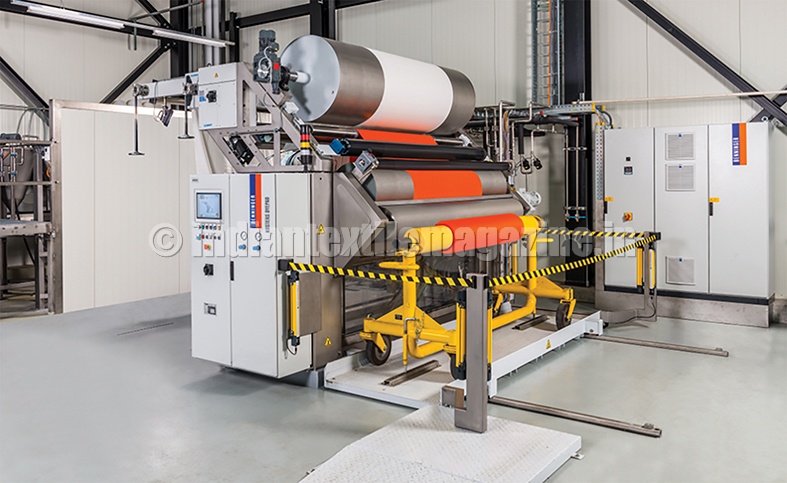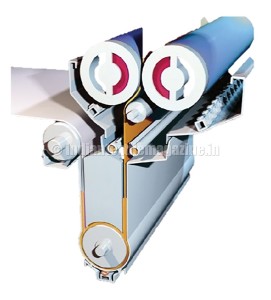Küsters is an integrated brand name of Benninger AG in Uzwil, Switzerland. The Küsters S-roller technology is now a recognised brand and stands for a safe, reproducible dyeing method, the CPB cold, pad, batch process. The CPB process is becoming increasingly important, as it can be used to dye both short and long yardages of woven and knitted fabric very economically. The initial scepticism towards a new technology is becoming overcome with the positive experiences made in industrial practice with an established technology.
The new Küsters S-roller technology, with the very latest technical features combined with modern control equipment and electronics supplied by the Benninger AG mechanical engineering division provides the technical process conditions that are expected of such a process today.
Dyeing is a very complex process influenced as it is by a number of parameters. Dyeing results are now not only gauged by visual assessment, but technical measuring instruments that can determine these results accurately and precisely have also become established in customer circles.
In addition, correction of dyeing faults is time-consuming and expensive. Furthermore, ecological sustainability demands are constantly rising, especially with regard to consumption of natural resources, and are increasingly becoming a cost factor that affects decisions. CPB dyeing with reactive dyes is a cost-effective process with a very high level of reproducibility.
Impregnation in the padder is the most important part of CPB dyeing. This is where the foundation for the dyeing results is laid. There are naturally also a number of other factors affecting the process that also require consideration but cannot be directly influenced by a plant engineer.
On the surface the demand for an application system for forced application is relatively simple. It must be ensured that the dye can be equally and constantly applied across the entire width of the fabric after a short period of contact with the dye liquor. This is possible only if the squeezing pressure and the squeezing nip can be kept constant. This task becomes complicated when the properties of the material to be dyed have to be included in calculations.
From a purely technical viewpoint, conditions are affected by different fibre and yarn thicknesses, absorbency, fabric tension, weft distortion, admission moisture content and liquor temperature, dye properties and errors such as dye migration at the selvedges during drying. For this reason the requirements to be met by an application system are complicated and can only be satisfied by the use of state-of-the-art control and instrumentation equipment. It is therefore necessary to deliberately control regular liquor application over the entire fabric width to correct the different influencing factors.
The new Küsters / Benninger S-roller technology ensures even liquor application over the entire fabric width as well as deliberately different liquor application in the “edge-centre-edge” areas. With the integration of modern instrumentation and control this can be adjusted simply and in a reproducible manner or controlled and regulated as required. The new Küsters S-roller technology now offers new and extended correction potential.
Reproducibility is maximised by an electronic pressure system (patented) that ensures controllable line forces over the entire roller width. In addition, dyers have a higher level of flexibility that offers decisive advantages, especially when dyeing knitwear and stretch woven fabric. With the further development of a specific roller coating, the “Blue Nip”, it can be ensured that the necessary application conditions can be transferred to the dyed goods optimally and durably.
Higher-level technologies that ensure additional process safety from a technical viewpoint, such as tailing correction and the cleverly designed dosing system with the track-proven Contidos as well as the new four-circuit cooling and temperature management enhance the ease of handling of the dyeing padder and its reproducibility. With computer-aided simulation the flow conditions at various speeds and with various fabric qualities were tested to prevent the so-called dead zones in the dyeing trough, and resulted in the development of the “mini U-Flow”. It was therefore possible to improve additional influencing factors to achieve optimum dyeing results, which also has positive effects on dye consumption. With the Telelink it is possible to transfer online optimisations from the Benninger AG competence centre to the system and check its efficiency at any time.
In summary it can be said that Benninger has succeeded in providing dyers with an intelligent dyeing machine by integrating the very latest electronic equipment into the further-developed Küsters S-roller technology. These offer a high level of reproducibility and flexibility. The same dyeing results can be achieved with the same recipes, even after several years. Never before has it been possible to control or regulate so many dyeing parameters so accurately.
Therefore, the described advantages, especially in comparison with exhaust dyeing, that range from a significantly lower water consumption per kilo of dyed goods, very low electrolyte consumption, low tension and abrasion processes (no pilling, no enzyme treatment necessary) and therefore no weight loss, are not only perceived in the dyeing shop and in the quality of textiles but are becoming increasingly important from an economic viewpoint.

